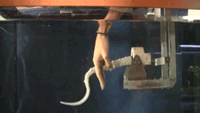Robot Octopus Points the Way to Soft Robotics With Eight Wiggly Arms
 Cecilia Laschi for IEEE Spectrum: The sun was sparkling on the Mediterranean Sea on the afternoon when a graduate student from my lab tossed our prize robot into the water for the first time. I watched nervously as our electronic creation sank beneath the waves. But the bot didn’t falter: When we gave it the command to swim, it filled its expandable mantle with water, then jetted out the fluid to shoot forward. When we ordered it to crawl, it stiffened its eight floppy arms in sequence to push itself along the sandy bottom and over scattered rocks. And when we instructed it to explore a tight space beneath the dock, the robot inserted its soft body into the narrow gap without difficulty.
Cecilia Laschi for IEEE Spectrum: The sun was sparkling on the Mediterranean Sea on the afternoon when a graduate student from my lab tossed our prize robot into the water for the first time. I watched nervously as our electronic creation sank beneath the waves. But the bot didn’t falter: When we gave it the command to swim, it filled its expandable mantle with water, then jetted out the fluid to shoot forward. When we ordered it to crawl, it stiffened its eight floppy arms in sequence to push itself along the sandy bottom and over scattered rocks. And when we instructed it to explore a tight space beneath the dock, the robot inserted its soft body into the narrow gap without difficulty.
As a professor at the BioRobotics Institute at the Scuola Superiore Sant’Anna, in Pisa, Italy, I lead a team investigating soft robotics. This relatively new field of research has the potential to upend our ideas about what robots are capable of and where they can be useful. I chose to build robots that mimic the form of the octopus for two reasons. First, because they’re well suited to demonstrate the many advantages that come when a machine can flex and squish as needed. Also, it’s an excellent engineering challenge: An octopus with eight wiggly arms, which must work together in the face of complex hydrodynamic forces, is very difficult to design and control. Cont'd...
Comments (0)
This post does not have any comments. Be the first to leave a comment below.
Featured Product

